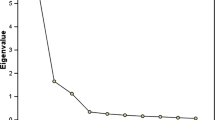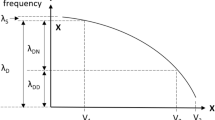Abstract
This paper presents a quantitative methodology for rockfall risk analysis focusing on highway crystalline rock slopes. The proposed method resulted in a risk classification given by a matrix, which relates the rockfall likelihood, with its consequence. The likelihood considers the characteristics of the rock masses and the consequence takes into account the chance of the block reaching the highway and causing accidents. The rockfall likelihood and the consequences are obtained by equations, whose values allow classifying the slopes as high, medium (transition zone), or low rockfall risk. These equations and the matrix of the risk analysis system were generated using linear discriminant analysis and confidence ellipses, both multivariate statistical techniques. Principal component analysis was applied to the dataset before the linear discriminant analysis in order to change qualitative variables into quantitative ones. To establish the classes of failure likelihood and its consequences, cluster analysis was applied. Afterwards, discriminant analysis was applied using the scores of the principal components as independent variables and the resulting clusters as dependent variables. The dataset used in this research has 220 rock slopes and the main variables considered are the parameters traditionally used in hazard and risk classifications for highway slopes.













Similar content being viewed by others
Data Availability
The codes used to cluster analysis during the current study are available in the Github repository, https://github.com/larissarcs/PAM_cluster_Likelihood
The codes used to perform the Principal Component Analysis, Discriminant Analysis and Confidence Ellipses analysis during the current study are available in the Github repository, https://github.com/larissarcs/PCA-and-Discriminant-Analysis. The datasets analysed during the current study are available from the corresponding author on reasonable request.
References
Alvioli M, Santangelo M, Fiorucci F, Cardinali M, Marchesini I, Reichenbach P, Rossi M, Guzzetti F, Peruccacci S (2021) Rockfall susceptibility and network-ranked susceptibility along the Italian railway. Eng Geol 293:106301. https://doi.org/10.1016/j.enggeo.2021.106301
Ansari MK, Ahmad M, Singh R, Singh TN (2016) Rockfall hazard rating system along SH-72: a case study of Poladpur-Mahabaleshwar road (Western India), Maharashtra, India. Geomat Nat Haz Risk 7(2):649–666. https://doi.org/10.1080/19475705.2014.1003416
Barrett RK, White JL (1991) Rockfall prediction and control, national symposium on highway and railroad slope maintenance. 34th annual meeting of the association of engineering geologists, pp. 23–40.
Bartlett MS (1951) The effect of standardization on a chi square approximation in factor analysis. Biometrika 38:337–344
Bostjančić I, Pollak D (2020) Rockfall threat assessment along railways in carbonate rocks in Croatia. Bull Eng Geol Environ 79:3921–3942. https://doi.org/10.1007/s10064-020-01822-x
Box G (1949) A general distribution theory for a class of likelihood criteria. Biometrika 36:317–346
Budetta P, De Luca C, Nappi M (2016) Quantitative rockfall risk assessment for an important road by means of the rockfall risk management (RO.MA.) method. Bull Eng Geol Environ 75:1377–1397. https://doi.org/10.1007/s10064-015-0798-6
Charrad M, Ghazzali N, Boiteau V, Niknafs A (2015) NbClust: determining the best number of clusters in a data set. R Package, version 3.0. In: https://CRAN.Rproject.org/package=NbClust.
Efron B (1992) Bootstrap methods: another look at the jackknife. Breakthroughs in statistics. Springer, New York, pp 569–593
Fisher R (1936) The use of multiple measurements in taxonomic problems. Ann Eugen 7:179–188
Guzzetti F, Crosta G, Detti R, Agliardi F (2002) STONE: a computer program for the three-dimensional simulation of rock-falls. Comput Geosci 28:1079–1093. https://doi.org/10.1016/S0098-3004(02)00025-0
Hair J, Black W, Babin B, Anderson R (2010) Multivariate data analysis. Prentice Hall, New Jersey
Hoek E (2007) Practical Rock Engineering: RocScience. (Available from the publisher at http://www.rocscience.com/hoek/PracticalRockEngineering.asp).
Hotelling H (1933) Analysis of a complex of statistical variables into principal components. J Educ Psychol 24:417–441
Inc R (2012a) Phase V8 software. Ontario, Canada, Toronto
Rocscience Inc: (2012b), ROCFALL-computer program for risk analysis of falling rocks on steep slopes. Version4.0, Toronto, Rocscience user's guide, 59.
Kassambara A (2017) Practical guide to cluster analysis in R unsupervised machine learning. STHDA, London
Kaufman L, Rousseeuw PJ (1990) Finding groups in data: an introduction to cluster analysis. Wiley Series in Probability and Statistics. ISBN: 0-47 1-73578-7.
Khajevand R (2023) Prediction of the uniaxial compressive strength of rocks by soft computing approaches. Geotech Geol Eng 41:3549–3574. https://doi.org/10.1007/s10706-023-02473-x
Maerz NH, Youssef A, Fennessey TW (2005) New risk-consequence rockfall hazard rating system for Missouri highways using digital image analysis. Environ Eng Geosci 11:229–249
Mcmillan PZ, Matheson GD (1998) Rock slope hazard assessment: a new approach. London: Engineering geology special publications N. 15, P. 177–183.
Peila D, Guardini C (2008) Use of the event tree to assess the risk reduction obtained from rockfall protection devices. Nat Hazards Earth Syst Sci 8:1441–1450
Pierson LA, Van Vickle R (1993) Rockfall hazard rating system. Transportation Research record N° 1343, National research board, Washington, D.C., pp 6–19.
R Core Team (2020) R: A language and environment for statistical computing. R Foundation for Statistical Computing, Vienna, Austria. URL https://www.R-project.org/.
Ritchie AM (1963) Evaluation of rockfall and its control. U. S. Department of commerce, Bureau of public roads, and the Washington State Highway Commission.
Royston JB (1983) Some techniques for assessing multivariate based on the Shapiro-Wilk W. Appl Stat London 32(2):121–133
Santi PM, Russel CP, Higgins JD, Spriet JI (2009) Modification and statistical analysis of the colorado rockfall hazard rating system. Eng Geol 104:55–65. https://doi.org/10.1016/j.enggeo.2008.08.009
Santos AEM, Lana MS, Cabral IE, Pereira TM, Naghadehi MZ, Silva DFS, Santos TB (2018) Evaluation of rock slope stability conditions through discriminant analysis. Geotech Geol Eng 37:775–802. https://doi.org/10.1007/s10706-018-0649-x
Santos TB, Lana MS, Pereira TM, Canibulat I (2019) Quantitative hazard assessment system (Has-q) for open pit mine slopes. Int J Min Sci Technol 29(3):419–427. https://doi.org/10.1016/j.ijmst.2018.11.005
Sardana S, Sinha RK, Verma AK, Jaswal M, Singh TN (2022) A Semi-empirical approach for rockfall prediction along the Lengpui-Aizawl highway Mizoram, India. Geotech Geol Eng 40:5507–5525. https://doi.org/10.1007/s10706-022-02229-z
Sharma LK, Umrao RK, Singh R, Singh TN (2020) Assessment of rockfall hazard of hill slope along Mumbai-Pune expressway, Maharashtra, India. Acta Geodyn Geomater 17(3):285–296. https://doi.org/10.13168/AGG.2020.0021
Tinsley HEA, Steven DB (2000) Handbook of applied multivariate statistics and mathematical modeling. 1ª ed. San Diego: Academic Press. 721 p. ISBN: 0-12-691360-9.
Verma AK, Sardana S, Sharma P, Dinpuia L, Singh TN (2019) Investigation of rockfall-prone road cut slope near Lengpui Airport, Mizoram, India. J Rock Mech Geotech Eng 11(1):146–158. https://doi.org/10.1016/j.jrmge.2018.07.007
Verma AK, Sinha RK, Sardana S, Jaswal M, Singh TN (2021) Investigation into the Rockfall hazard along Lengpui-Aizawl highway, NH-44A, Mizoram, India. Indian Geotech J 51(4):732–745. https://doi.org/10.1007/s40098-021-00506-x
Acknowledgements
The authors acknowledge CNPq (National Counsel of Technological and Scientific Development), Fapemig (Foundation for Research Support of Minas Gerais), Brazilian Federal Agency for Support and Evaluation of Graduate Education (CAPES) and Federal University of Ouro Preto (UFOP) for supporting this work and the PhD Paul Santi, Professor of Colorado School of Mines, to provide the database used in this research.
Funding
The authors declare that no funds, grants, or other support were received during the preparation of this manuscript.
Author information
Authors and Affiliations
Contributions
All authors contributed to the study conception and design. Material preparation, data collection and analysis were performed by LRCS, MSL and TBdosS. The first draft of the manuscript was written by LRCS and all authors commented on previous versions of the manuscript. All authors read and approved the final manuscript.
Corresponding author
Ethics declarations
Conflict of interest
The authors have no relevant financial or non-financial interests to disclose.
Additional information
Publisher's Note
Springer Nature remains neutral with regard to jurisdictional claims in published maps and institutional affiliations.
Rights and permissions
Springer Nature or its licensor (e.g. a society or other partner) holds exclusive rights to this article under a publishing agreement with the author(s) or other rightsholder(s); author self-archiving of the accepted manuscript version of this article is solely governed by the terms of such publishing agreement and applicable law.
About this article
Cite this article
Silveira, L.R.C., Lana, M.S. & dos Santos, T.B. A Quantitative Rockfall Risk Analysis System for Highway Rock Slopes. Geotech Geol Eng 42, 1131–1152 (2024). https://doi.org/10.1007/s10706-023-02609-z
Received:
Accepted:
Published:
Issue Date:
DOI: https://doi.org/10.1007/s10706-023-02609-z




